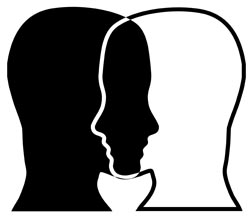Extended Minds: The Mental Fields Within & Beyond Our
Brains

By RUPERT SHELDRAKE, Ph.D.
Mental fields are rooted in brains, just as magnetic fields around magnets are rooted in the magnets themselves, or just as the fields of transmission around mobile phones are rooted in the phones and their internal electrical activities. As magnetic fields extend around magnets, and electromagnetic fields around mobile phones, so mental fields extend around brains.
Mental fields help to explain telepathy, the sense of being stared at and other widespread but unexplained abilities. Above all, mental fields underlie normal perception. They are an essential part of vision.
Images Outside Our Heads
The inward movement of light is familiar enough. As you look at this page, reflected light moves from the page through the electromagnetic field into your eyes. The lenses of your eyes focus the light to form upside-down images on your retinas. This light falling on your retinal rod and cone cells causes electrical changes within them, which trigger off patterned changes in the nerves of the retina. Nerve impulses move up your optic nerves and into the brain, where they give rise to complex patterns of electrical and chemical activity. So far, so good. All these processes can be, and have been, studied in great detail by neurophysiologists and other experts on vision and brain activity.
But then something very mysterious happens. You consciously experience what you are seeing, the page in front of you. You also become conscious of the printed words and their meanings. From the point of view of the standard theory, there is no reason why you should be conscious at all. Brain mechanisms ought to go on just as well without consciousness.
The standard theory of vision applies to all species of animals with image-forming eyes. It does not explain why there should be conscious vision in any animal species, or in people. There is just unconscious, computer-like data-processing by the nervous system.
Then comes a further problem. When you see this page, you do not experience your image of it as being inside your brain, where it is supposed to be. Instead, you experience its image as being located about two feet in front of you. The image is outside your body.
For all its physiological sophistication, the standard theory has no explanation for your most immediate and direct experience. All your experience is supposed to be inside your brain, not where it seems to be.
The basic idea I am proposing is so simple that it is hard to grasp. Your image of this page is just where it seems to be, in front of your eyes, not behind your eyes. It is not inside your brain, but outside your brain.
Thus vision involves both an inward movement of light, and an outward projection of images. Through mental fields our minds reach out to touch what we are looking at. If we look at a mountain ten miles away, our minds stretch out ten miles. If we gaze at distant stars our minds reach out into the heavens, over literally astronomical distances.
The Sense of Being Stared At
This question can be explored through simple, inexpensive experiments. People work in pairs. One person, the subject, sits with his or her back to the other, wearing a blind-fold. The other person, the looker, sits behind the subject, and in a random series of trials either looks at the subject’s neck, or looks away and think of something else. The beginning of each trial is signalled by a mechanical clicker or bleeper. Each trial lasts about ten seconds and the subject guesses out loud “looking” or “not looking.” Detailed instructions are given on my website, www.sheldrake.org.
More than 100,000 trials have now been carried out, and the results are overwhelmingly positive and hugely significant statistically, with odds against chance of quadrillions to one. The sense of being stared at even works when people are looked at through closed-circuit TV. Animals are also sensitive to being looked at by people, and people by animals. This sensitivity to looks seems widespread in the animal kingdom and may well have evolved in the context of predator-prey relationships: an animal that sensed when an unseen predator was staring would stand a better chance of surviving than an animal without this sense.
Telepathy
Most people who espouse these opinions, which I used to myself, do not do so on the basis of a close examination of the evidence. They do so because there is a taboo against taking telepathy seriously. This taboo is related to the prevailing paradigm or model of reality within institutional science, namely the mind-inside-the-brain theory, according to which telepathy and other psychic phenomena, which seem to imply mysterious kinds of ‘action at a distance’, cannot possibly exist.
This taboo dates back at least as far as the Enlightenment at the end of the eighteenth century. But this is not the place to examine its history (which I discuss in The Sense of Being Stared At). Rather I want to summarise some recent experiments, which suggest that telepathy not only exists, but that it is a normal part of animal communication.
Psychic Pets
Through public appeals I have built up a large database of such stories, currently containing more than 4,700 case histories. These stories fall into several categories. For example, many cat owners say that their animal seem to sense when they are planning to take them to the vet, even before they have taken out the carrying basket or given any apparent clue as to their intention. Some people say their dogs know when they are going to be taken for a walk, even when they are in a different room, out of sight or hearing, and when the person is merely thinking about taking them for a walk. Of course, no one finds this behaviour surprising if it happens at a routine time, or if the dogs see the person getting ready to go out, or hear the word “walk.” They think it is telepathic because it seems to happen in the absence of such clues.
One of the commonest and most testable claims about dogs and cats is that they know when their owners are coming home, in some cases anticipating their arrival by ten minutes or more. In random household surveys in Britain and America, my colleagues and I have found that approximately 50% of dog owners and 30% of cat owners believe that their animals anticipate the arrival of a member of the household. Through hundreds of videotaped experiments, my colleagues and I have shown that dogs react to their owners’ intentions to come home even if they are many miles away, even when they return at randomly-chosen times, and even when they travel in unfamiliar vehicles such as taxis. Telepathy seems the only hypothesis that can account for the facts. (For more details, see my book Dogs that Know When their Owners Are Coming Home, And Other Unexplained Powers of Animals.)
Telephone Telepathy
This lead me to reflect that I myself had had this kind of experience, in that I had thought of people for no apparent reason who shortly there afterwards called. I asked my family and friends if they had ever had this experience, and I soon found the majority were very familiar with it. Some said they knew when their mother or boyfriend or other significant person was calling because the phone sounded different!
Through extensive surveys, my colleagues and I have found that most people have had seemingly telepathic experiences with telephone calls. Indeed this is the commonest kind of apparent telepathy in the modern world.
Is this all a matter of coincidence, and selective memory, whereby people only remember when someone they were thinking about rang, and forget all the times they were wrong? Most sceptics assume that this is the case, but until recently there had never been any scientific research on the subject at all.
I have developed a simple experiment to test for telephone telepathy. Participants receive a call from one of four different callers at a prearranged time, and they themselves choose the callers, usually close friends or family members. For each test, the caller is picked at random by the experimenter by throwing a dice, or by using a computerised random-number generator. The participant has to say who the caller is before the caller says anything. If people were just guessing, they would be right about one time in four, or 25% of the time.
We conducted more than 800 such trials, and the average success rate is 42%, very significantly above the chance level of 25%, with astronomical odds against chance.
We also carried out a series of trials in which two of the four callers were familiar, while the other two were strangers, whose names the participants knew, but whom they had not met. With familiar callers, the success rate was 56%, highly significant statistically. With strangers it was at the chance level, in agreement with the observation that telepathy typically takes place between people who share emotional or social bonds.
In addition, we have found that these effects do not fall off with distance. Some of our participants were from Australia or New Zealand, and they could identify who was calling just as well as with people down under as with people only a few miles away.
Telepathic emails and text messages are the latest version of this phenomenon, and an extensive series of experiments with emails has given very similar results to the telephone experiments. Positive and highly significant statistically. (The details of all this research on telepathy in people and in pets are published in a series of papers in peer-reviewed journals, and the full texts are available on my web site).
An automated version of the telephone telepathy test that works on mobile telephones is now up and running and can be accessed from the Online Experiments Portal on my web site, www.sheldrake.org.
Extended Minds
 Laboratory studies by
parapsychologists have already provided significant statistical evidence for
telepathy (well
reviewed by Dean Radin in his book The Conscious Universe, Harper 1997).
But most laboratory research has given rather weak effects, probably because
most participants and “senders” were strangers to each other, and telepathy
normally depends on social bonds.
Laboratory studies by
parapsychologists have already provided significant statistical evidence for
telepathy (well
reviewed by Dean Radin in his book The Conscious Universe, Harper 1997).
But most laboratory research has given rather weak effects, probably because
most participants and “senders” were strangers to each other, and telepathy
normally depends on social bonds.The results of telephone telepathy experiments give much stronger and more repeatable effects because they involve people who know each other well. I have also found that there are striking telepathic links between nursing mothers and their babies. Likewise, the telepathic reactions of pets to their owners depend on strong social bonds.
I suggest that these bonds are aspects of the fields that link together members of social groups (which I call morphic fields) and which act as channels for the transfer of information between separated members of the group. Telepathy literally means “distant feeling,” and typically involves the communication of needs, intentions and distress. Sometimes the telepathic reactions are experienced as feelings, sometimes as visions or the hearing of voices, and sometimes in dreams. Many people and pets have reacted when people they are bonded to have had an accident, or are dying, even if this is happening many miles away.
There is an analogy for this process in quantum physics: if two particles have been part of the same quantum system and are separated in space, they retain a mysterious connectedness. When Einstein first realised this implication of quantum theory, he thought quantum theory must be wrong because it implied what he called “spooky action at a distance.” Experiments have shown that quantum theory is right and Einstein wrong. A change in one separated part of a system can affect another instantaneously. This phenomenon is known as quantum non-locality or non-separability.
Telepathy, like the sense of being stared at, is only paranormal if we define as “normal” the theory that the mind is confined to the brain. But if our minds reach out beyond our brains, just as they seem to, and connect with other minds, just as they seem to, then phenomena like telepathy and the sense of being stared at seem normal. They are not spooky and weird, on the margins of abnormal human psychology, but are part of our biological nature.
Of course, I am not saying that the brain is irrelevant to our understanding of the mind. It is very relevant, and recent advances in brain research have much to tell us. Our minds are centred in our bodies, and in our brains in particular. However, they are not confined to our brains, but extend beyond them. This extension occurs through the fields of the mind, or mental fields, which exist both within and beyond our brains.
The idea of the extended mind makes better sense of our experience than the mind-in-the-brain theory. Above all, it liberates us. We are no longer imprisoned within the narrow compass of our skulls, our minds separated and isolated from each other. We are no longer alienated from our bodies, from our environment and from other people. We are interconnected.
The new edition of Dr. Sheldrake’s classic book The Sense of Being Stared At, And Other Unexplained Powers of Human Minds, is available from all good bookstores and online retailers.
DR. RUPERT SHELDRAKE is a biologist and author of more than 80 papers in scientific journals and ten books. His book The Sense of Being Stared At, And Other Unexplained Powers of Human Minds, has just been released in a new edition by Park Street Press. He was a Fellow of Clare College, Cambridge and a Research Fellow of the Royal Society. From 2005-2010 he was the Director of the Perrott-Warrick Project, funded from Trinity College, Cambridge University. He is a Fellow of the Institute of Noetic Sciences, near San Francisco, and a visiting Professor at the Graduate Institute in Connecticut. He lives in London with his wife, Jill Purce, and their two sons. His web site is www.sheldrake.org.
The above article appeared in New
Dawn No. 140 (September-October 2013)
© New Dawn Magazine and the respective author.
For our reproduction notice, click here.
For our reproduction notice, click here.
For Rupert Sheldrake’s full length Extended Minds video see http://nexusilluminati.blogspot.com.au/2010/04/extended-mind-experimental-evidence-of.html
For more information about telepathy and psychic abilities see http://nexusilluminati.blogspot.com/search/label/psi
- See ‘Older Posts’ at the end of each section
Hope you like this
not for profit site -
It takes hours of work every day
to maintain, write, edit, research, illustrate and publish this website from a
tiny cabin in a remote forest
Like what we do? Please give enough
for a meal or drink if you can -
Donate any amount and receive at least one New Illuminati eBook!
Please click below -

Xtra Images by R. Ayana – http://farm9.staticflickr.com/8199/8157191995_027f3e4025_b.jpg
For further enlightening
information enter a word or phrase into the random synchronistic search box @ http://nexusilluminati.blogspot.com
And see
New Illuminati – http://nexusilluminati.blogspot.com
New Illuminati on Facebook - https://www.facebook.com/the.new.illuminati
New Illuminati Youtube Channel - http://www.youtube.com/user/newilluminati/feed
New Illuminati on Google+ @ https://plus.google.com/115562482213600937809/posts
New Illuminati on Twitter @ www.twitter.com/new_illuminati
The Her(m)etic Hermit - http://hermetic.blog.com
The Prince of Centraxis - http://centraxis.blogspot.com (Be Aware! This link leads to implicate &
xplicit concepts & images!)
DISGRUNTLED SITE ADMINS PLEASE NOTE –
We provide a live link to your original material on your site (and
links via social networking services) - which raises your ranking on search
engines and helps spread your info further! This site is
published under Creative Commons Fair Use Copyright (unless an individual
article or other item is declared otherwise by the copyright holder) –
reproduction for non-profit use is permitted & encouraged, if you
give attribution to the work & author - and please include a (preferably
active) link to the original (along with this or a similar notice).
Feel free to make non-commercial hard (printed) or software copies or
mirror sites - you never know how long something will stay glued to the web –
but remember attribution! If you like what you see, please send a donation (no
amount is too small or too large) or leave a comment – and thanks for reading
this far…
Live long and prosper! Together we can create the best of all possible
worlds…
From the New
Illuminati – http://nexusilluminati.blogspot.com


No comments:
Post a Comment
Add your perspective to the conscious collective